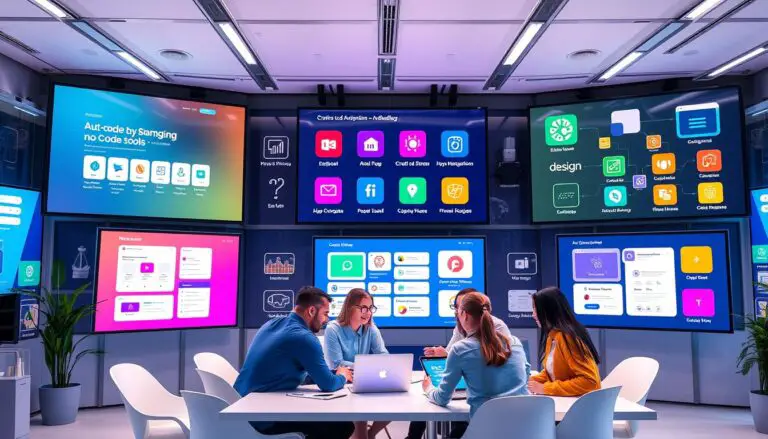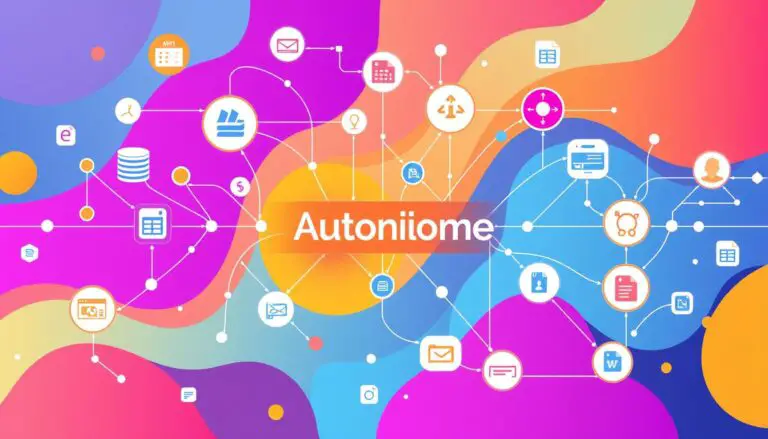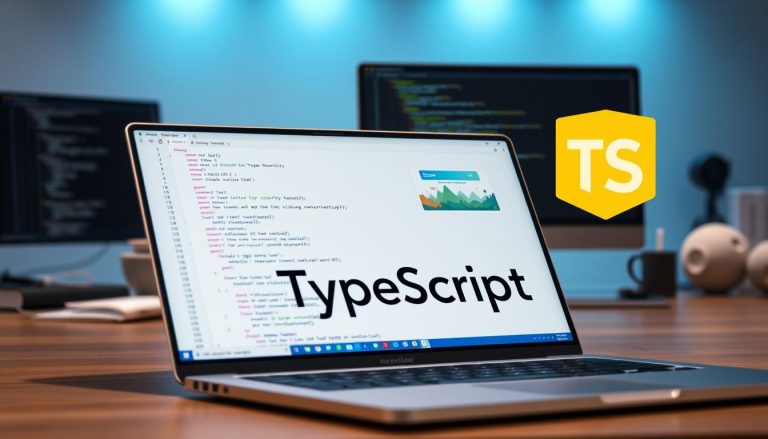We Explore the Easiest Coding Language in 2025 for New Developers
What if the best first step into the tech world isn’t about finding the simplest tool, but the most empowering one? For anyone starting their journey today, this initial choice is more than just picking a syntax; it’s about setting the trajectory for an entire career.
We believe that an accessible programming language for new developers combines intuitive structure with powerful potential. It should have a gentle learning curve, a vibrant community for support, and the ability to create tangible results quickly. This builds confidence and momentum.
Our evaluation looks beyond mere popularity. We analyze factors like readability, the availability of learning resources, current job market demand, and versatility across different project types. The tech landscape is dynamic, and we focus on languages with lasting relevance.
This guide provides a detailed, research-backed analysis to help you make an informed decision. We draw from industry trends and expert insights to cut through the noise. You will discover clear pathways to begin your software development journey with confidence.
Key Takeaways
- The first programming language you learn can significantly influence your career path and learning experience.
- “Easiest” often means a language with clear syntax, strong community support, and abundant learning materials.
- Effective evaluation considers readability, job market demand, and versatility for various applications.
- This guide offers authoritative, data-driven insights to simplify your decision-making process.
- The goal is to select a language that allows you to build functional projects and gain momentum quickly.
Introduction to the Coding Landscape in 2025
The professional programming environment today is both vast and surprisingly concentrated. While over 700 programming languages see widespread use, industry professionals typically focus on a core group of about 20. This creates a more navigable field for new developers.
Overview of Today’s Programming Environment
Data from Pluralsight’s 2025 meta-study of 50,000 learners confirms Python’s dominance. It is followed by Java and JavaScript. This ranking reflects the industry’s strong push into AI and data science.
Simultaneously, Stack Overflow’s survey shows JavaScript’s enduring popularity. For eleven consecutive years, it has been the most widely used language. This underscores the lasting importance of web development skills.
Why 2025 is Pivotal for New Developers
The convergence of AI, cloud, and mobile tech has created diverse opportunities. Beginners can now find clear paths, like Python for data science or Swift for iOS apps. This specialization simplifies early career choices.
Furthermore, access to education has been democratized. Bootcamps and online platforms make skill acquisition more accessible than ever. This makes the current period an ideal time to start a journey in software development.
Understanding Programming Languages in the Modern Era
Programming languages serve as the fundamental bridge between human creativity and computational power, enabling developers to build the digital world around us. We believe grasping these tools is essential for anyone entering software development today.
What is a Programming Language?
A programming language represents a structured set of instructions written in specific syntax. This syntax tells computers exactly what tasks to perform and how to execute them.
Mastering any programming language empowers creators to build diverse digital solutions. These include software applications, interactive websites, and innovative tools that drive technological advancement.
Major Types and Their Applications
Different programming languages follow distinct paradigms suited for various applications. Procedural languages like C and Pascal approach problems through step-by-step procedures.
Object-oriented languages such as Python and Java organize code around objects containing both data and behaviors. This creates modular, reusable components.
Functional languages like Haskell emphasize working with data structures without modification. Scripting languages including JavaScript automate tasks and add web interactivity.
Understanding these categories helps developers select the right tool for their specific problems and desired applications.
Key Trends Shaping Programming in 2025
In 2025, several key forces are actively reshaping the priorities and tools used by software professionals. We see artificial intelligence and shifting industry standards creating a new environment for development.
The Role of AI and Machine Learning
Artificial intelligence and machine learning have become central to modern programming. Python’s sustained popularity is largely due to its powerful libraries for data science and machine learning.
Companies are rushing to adopt AI, creating high demand for developers skilled in these areas. However, a critical challenge emerges. Many organizations have not prepared their underlying data.
This oversight predicts a surge in need for professionals skilled in data manipulation tools like SQL. Effective data science relies on clean, organized information.
Industry Shifts and Developer Preferences
Developer preferences are evolving toward tools that balance power with accessibility. The community values languages that support emerging tech.
Rust demonstrates this shift perfectly. Its popularity is climbing steadily due to a focus on memory safety and performance. It is expected to soon break into the top programming languages.
Modern development also favors cloud-native architectures. This trend prioritizes languages with strong support for building scalable, distributed systems.
- AI Integration: Tools that support machine learning are now essential.
- Data Foundation: Clean data is the bedrock of successful AI projects.
- Modern Paradigms: Cloud and microservices shape language choice.
Top Strategies for New Developers
Effective learning in software development requires a deliberate approach that combines solid fundamentals with modern educational tools. We outline key strategies to build momentum and avoid common pitfalls.
Building a Strong Foundation in Coding
Successful developers begin by mastering core concepts. These include variables, control structures, and basic algorithms.
This foundational knowledge creates a versatile skill set. It allows you to approach problems logically, regardless of the specific technology.
Developing strong problem-solving abilities is crucial. Consistent practice with small projects reinforces this learning and builds confidence.
Leveraging Bootcamps and Online Resources
Coding bootcamps offer an accelerated path into the industry. For example, Fullstack Academy’s Software Engineering Immersive focuses on full stack JavaScript.
Their programs are designed for career readiness in just a few months. This intensive model provides structured learning and expert guidance.
The vast online ecosystem is another powerful asset. Tutorials, forums, and frameworks provide immediate support for beginners.
Engaging with hands-on projects from the start is essential. It turns theoretical knowledge into practical, portfolio-ready skills.
Exploring the Easiest Coding Language in 2025
When we evaluate a programming language for newcomers, the concept of ‘ease’ extends far beyond simple syntax. We consider a gentle learning curve, robust community support, and the ability to create tangible results quickly.
Defining “Ease” in the Context of Coding
For beginners, an accessible programming language often features syntax that resembles natural language. Python exemplifies this with its clear, English-like structure. This readability helps new developers understand code logic almost intuitively.
JavaScript also offers a relatively straightforward path for learning. Its clear syntax is powerful for web development, especially when combined with HTML and CSS knowledge. This combination allows for creating interactive web pages early in the journey.
After mastering JavaScript, TypeScript becomes a logical next step. As an open-source superset, it builds directly on existing skills. It adds type safety, helping to prevent common errors in larger projects.
It’s important to note that “easiest” is subjective. A developer’s background and goals influence which language feels most natural. Some may prefer the mathematical focus of Python, while others thrive on the visual feedback of web development with JavaScript.
The best first language is one that balances approachability with real-world power. Many professionals start with these tools and continue using them throughout their careers. Exploring options like Go can also be beneficial after gaining initial experience.
Impact of Simplicity on Developer Success
Clear, readable code isn’t just an aesthetic preference—it’s a fundamental factor that determines how effectively teams can collaborate and maintain software over time. We find that languages prioritizing straightforward syntax create more productive environments for both beginners and experienced professionals.
The Importance of Readable Syntax
Readable syntax reduces cognitive load significantly. Developers can focus on solving problems rather than deciphering cryptic code structures.
Python demonstrates this principle effectively. Its clean syntax resembles natural language, making programs inherently self-documenting. This approach minimizes the need for extensive comments.
JavaScript offers clear syntax that facilitates relatively easy initial learning. However, code can become difficult to debug in complex applications for those without systematic strategies.
How Simplicity Facilitates Learning and Innovation
Simplicity accelerates innovation by lowering experimentation barriers. Developers can rapidly prototype ideas without wrestling with boilerplate code.
Go prioritizes this through concise syntax that deliberately limits features. Google designed this language specifically to improve productivity at scale.
Swift incorporates modern design principles for safe, expressive code. Its compiler catches errors early while maintaining clear communication of intent.
Ruby’s philosophy centers on developer happiness through natural language-like syntax. This approach enables programmers to express complex logic in readable ways.
TypeScript presents an interesting tradeoff. Type annotations add extra code but provide long-term benefits through better tooling and error prevention.
Real-World Applications for Beginner Coders>
Understanding how programming languages translate into real-world projects gives beginners immediate purpose and direction. We see this practical focus as essential for building momentum and a professional portfolio.
Developing Web and Mobile Applications
JavaScript’s role in web development is nearly universal. It powers the interactive elements on major websites like Facebook and YouTube. This language is fundamental for creating dynamic web applications.
Its versatility extends to both front-end and back-end development with Node.js. This allows for full-stack development using a single toolset. Beginners can start building functional websites quickly.
Python offers a different path, strong in back-end systems and data science. It’s also excellent for scripting and even game development with frameworks. This breadth makes it a powerful choice for various applications.
For mobile platforms, Swift is the key for Apple app creation. Kotlin has become the preferred language for Android app development. Ruby excels in rapid web development through its Rails framework.
These practical uses provide clear goals. Building a personal web page or a simple mobile app demonstrates tangible progress. Exploring the nine best programming languages to learn can help you find your ideal starting point for these projects.
Integrating Industry Insights and Developer Skills
Modern technology companies evaluate developer candidates through a multifaceted lens that extends beyond coding ability. Technical proficiency in a specific programming language represents just the foundation of what employers seek.
What Employers Look For Today
Companies increasingly value problem-solving abilities and logical thinking alongside technical skills. Different programming roles require distinct cognitive approaches.
JavaScript developers need strong procedural reasoning, while Python programmers benefit from solution-focused mindsets. Java specialists require analytical thinking, and Go developers should understand systems architecture.
The financial rewards reflect these specialized demands. Python developers earn approximately $125,102 annually, while C# specialists command $155,210. Kotlin professionals average $131,852, demonstrating strong market value across multiple languages.
Scaling Skills from Basic to Advanced
Successful developers master fundamental concepts thoroughly before progressing to complex topics. This incremental approach builds sustainable competence.
Advanced skills develop through progressively challenging projects. Start with simple scripts, advance to dynamic web applications, then tackle complex systems with microservices.
Understanding computer science fundamentals separates mid-level programmers from true experts. Continuous learning through open-source contributions and industry engagement remains essential for career growth.
Resources and Learning Opportunities
The right learning path can transform a beginner’s curiosity into professional competency. We explore structured programs and platforms that provide clear guidance.

Recommended Courses and Bootcamps
Fullstack Academy offers intensive bootcamps completed in 13 to 22 weeks. Their live online instruction focuses on full stack JavaScript across all programs.
Students can select specialized tracks like AI or Cybersecurity. This aligns education with specific career goals from the start.
Insights from Expert Web Sources
Platforms like Pluralsight provide expert-authored Skill IQ tests. Learners answer questions about each scripting language to benchmark their skills.
Their beginner-to-expert pathways offer structured curricula for top programming languages. A free trial provides access to this vast library of resources.
The community of over 50,000 tech learners creates a rich support ecosystem. Widely used languages benefit from extensive tutorials and frameworks.
- Structured Bootcamps: Accelerated programs with live instruction and career-focused specializations.
- Skill Assessment: Platforms that help you measure your current level and track progress.
- Community Support: Large networks of developers provide invaluable troubleshooting guidance.
Technical Considerations and Future Trends
The technical architecture behind programming languages reveals critical distinctions in scalability and performance that directly impact project success. We examine how different tools handle growing demands and system requirements.
Scalability, Performance, and Future Demand
Java demonstrates exceptional stability for enterprise applications handling millions of transactions. Its efficiency prevents performance degradation across large systems.
C++ remains vital for high-performance computing despite its complexity. This tool provides direct hardware access for real-time simulations and financial trading systems.
Modern languages like Go simplify concurrent programming with built-in support. This architecture efficiently utilizes multi-core processors for cloud-native applications.
Rust’s memory safety features address longstanding systems programming challenges. Its performance comparable to C++ drives growing popularity for infrastructure projects.
Future demand favors tools supporting efficient memory operations and concurrent programming. As edge computing expands, these characteristics become increasingly valuable across industries.
Conclusion
The path to becoming a developer begins with a single, empowering decision that unlocks a world of creative potential. We have explored how different programming languages serve as gateways to this exciting field.
Your initial choice matters, but consistent practice matters more. The skills you build—logical thinking and systematic problem-solving—transfer across any technology stack.
The current landscape offers unprecedented support for beginners. Accessible resources and diverse career paths make this an ideal time to start your journey in software development.
Remember that professional developers often master multiple languages throughout their careers. The most widely used tools each serve specific purposes in creating modern applications.
We encourage you to begin with confidence. The best way forward is to start building projects and joining the global community of developers shaping our digital world.
FAQ
What is the most important factor when choosing a first programming language?
How does a simple programming language benefit web development projects?
Can a beginner-friendly language be used for data science and machine learning?
What role does community support play in learning to code?
How do I know if a programming language has good long-term prospects?
Are bootcamps effective for learning these in-demand programming skills?
- About the Author
- Latest Posts
Mark is a senior content editor at Text-Center.com and has more than 20 years of experience with linux and windows operating systems. He also writes for Biteno.com






